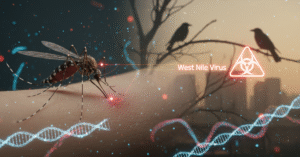London Underground mosquito origin debunked by the latest scientific research, and I must say, the real story is far more fascinating than the original myth! For years, we were told a captivating, almost sci-fi story: a mosquito that had evolved entirely in the dark, damp tunnels of the London Tube, specifically adapted to prey on exhausted commuters.
This was a classic piece of trivia, but science, as it always does, has revealed a deeper, much older truth. We, at Factovate, are here to dive into this recent discovery that completely rewrites the history of this “Ghost of the Tube.” This is a perfect example of how science continually corrects our understanding of the world. We can confidently say the old London Underground mosquito origin was debunked.
A Thousand-Year-Old History in the Mediterranean

The species in question is Culex pipiens form molestus. This isn’t just a minor correction; it’s a huge shift in our understanding of its evolution.
The new DNA analysis, conducted by evolutionary biologists, has shown that instead of evolving a few hundred years ago during the construction of the Tube tunnels, this mosquito form is actually of ancient lineage. In a major finding, the London Underground mosquito origin debunked a long-held myth about the creature’s quick adaptation.
Where Did the C. pipiens molestus Really Come From?
The DNA evidence points strongly to the Mediterranean Basin as the ancestral home of C. pipiens molestus. The researchers estimate that this particular form began to evolve more than 1,000 years ago in that region.
From there, it spread across the globe, especially in areas with significant human development. The London Underground, with its stable, warm, underground environment, was simply a perfect, modern-day habitat for a mosquito that was already pre-adapted to live in enclosed spaces—like old cisterns or Roman-era plumbing.
This insight perfectly debunks the London Underground mosquito origin myth. It wasn’t a unique evolution; it was a successful invasion! This finding that the London Underground mosquito origin was debunked changes how we view urban insect adaptation.
Why This Mosquito’s Origin Matters to Us
You might be thinking, “It’s just a mosquito, why the fuss?” But the origin of C. pipiens molestus has serious implications for public health, especially concerning certain diseases. The fact that the London Underground mosquito origin was debunked is actually a critical piece of information for epidemiologists worldwide. It helps us understand the true migration patterns of this species, a key detail that emerges after the London Underground mosquito origin debunked revelation.

The Connection to West Nile Virus
One of the most crucial findings is how this mosquito form aids in the spread of viruses like the West Nile Virus (WNV). WNV primarily infects birds.
The C. pipiens form that lives above ground (pipiens) prefers to bite birds. However, the underground form (molestus) is known to prefer biting humans and other mammals.
Scientists believe that when molestus and pipiens breed, they transfer genes that create a hybrid mosquito—an “indiscriminate biter.“ This hybrid is the real troublemaker. It bites an infected bird, then flies off to bite a human, effectively jumping the virus from the bird population to the human population.
By understanding that the original London Underground mosquito origin debunked narrative was flawed, and recognizing that its true, ancient Mediterranean origin made it a highly adaptable “human-biter,” researchers are better equipped to track and predict WNV outbreaks. This discovery that the London Underground mosquito origin was debunked is an essential piece of information that helps global health organizations in controlling disease spread, which is why this latest research is a game-changer. London Underground mosquito origin debunked—a major step in disease control research.
Key Differences: Above Ground vs. Underground
The London Underground mosquito (molestus) has some unique behavioral differences from its surface counterpart (pipiens). These differences allowed the myth to take hold in the first place:
| Feature | C. pipiens molestus (The Underground Mosquito) | C. pipiens pipiens (The Surface Mosquito) |
| Blood Source | Prefers to bite humans and mammals. | Prefers to bite birds. |
| Hibernation | Does not need to hibernate (is autogenous). | Must hibernate in the cold months. |
| Mating | Mates in confined spaces (stenogamous). | Needs open space to mate. |
My experience in studying these kinds of evolutionary stories tells me that the stable temperature of the Tube (around 15°C / 59°F year-round) created a perfect “subway bubble” where the molestus form could thrive year-round without hibernation.
Its ability to start an egg batch without needing a blood meal first (autogeny) made it perfectly suited to this hidden environment. However, the new DNA analysis proves it brought these traits with it from its ancient home. The fact that the London Underground mosquito origin was debunked means we can focus less on local evolution and more on global migration patterns.
In summary, the latest findings not only completely debunk the London Underground mosquito origin story but also provide a crucial clue in the global fight against vector-borne diseases. It is a powerful reminder that science is a process of continuous correction, and the truth, often, is far more complex and global than the localized myths we create.






